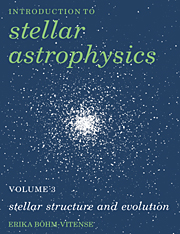Book contents
- Frontmatter
- Contents
- Preface
- 1 Introduction
- 2 Hydrostatic equilibrium
- 3 Thermal equilibrium
- 4 The opacities
- 5 Convective instability
- 6 Theory of convective energy transport
- 7 Depths of the outer convection zones
- 8 Energy generation in stars
- 9 Basic stellar structure equations
- 10 Homologous stars in radiative equilibrium
- 11 Influence of convection zones on stellar structure
- 12 Calculation of stellar models
- 13 Models for main sequence stars
- 14 Evolution of low mass stars
- 15 Evolution of massive stars
- 16 Late stages of stellar evolution
- 17 Observational tests of stellar evolution theory
- 18 Pulsating stars
- 19 The Cepheid mass problem
- 20 Star formation
- Appendix Radiative energy transport in stars
- Problems
- References
- Index
8 - Energy generation in stars
Published online by Cambridge University Press: 08 January 2010
- Frontmatter
- Contents
- Preface
- 1 Introduction
- 2 Hydrostatic equilibrium
- 3 Thermal equilibrium
- 4 The opacities
- 5 Convective instability
- 6 Theory of convective energy transport
- 7 Depths of the outer convection zones
- 8 Energy generation in stars
- 9 Basic stellar structure equations
- 10 Homologous stars in radiative equilibrium
- 11 Influence of convection zones on stellar structure
- 12 Calculation of stellar models
- 13 Models for main sequence stars
- 14 Evolution of low mass stars
- 15 Evolution of massive stars
- 16 Late stages of stellar evolution
- 17 Observational tests of stellar evolution theory
- 18 Pulsating stars
- 19 The Cepheid mass problem
- 20 Star formation
- Appendix Radiative energy transport in stars
- Problems
- References
- Index
Summary
Available energy sources
So far we have only derived that, because of the observed thermal equilibrium, the energy transport through the star must be independent of depth as long as there is no energy generation. The energy ultimately has to be generated somewhere in the star in order to keep up with the energy loss at the surface and to prevent the star from further contraction. The energy source ultimately determines the radius of the star.
Making use of the condition of hydrostatic equilibrium we estimated the internal temperature but we do not yet know what keeps the temperature at this level. In this chapter we will describe our present knowledge about the energy generation which prevents the star from shrinking further.
First we will see which energy sources are possible candidates. In Chapter 2 we talked about the gravitational energy which is released when the stars contract. We saw that the stars must lose half of the energy liberated by contraction before they can continue to contract. We might therefore suspect that this could be the energy source for the stars.
The first question we have to ask is how much energy is actually needed to keep the stars shining. Each second the sun loses an amount of energy which is given by its luminosity, L = 3.96 × 1033 ergs−1, as we discussed in Chapter 1. From the radioactive decay of uranium in meteorites we can find that the age of these meteorites is about 4.5 × 109 years. We also find signs that the solar wind has been present for about the same time.
- Type
- Chapter
- Information
- Introduction to Stellar Astrophysics , pp. 86 - 105Publisher: Cambridge University PressPrint publication year: 1992

